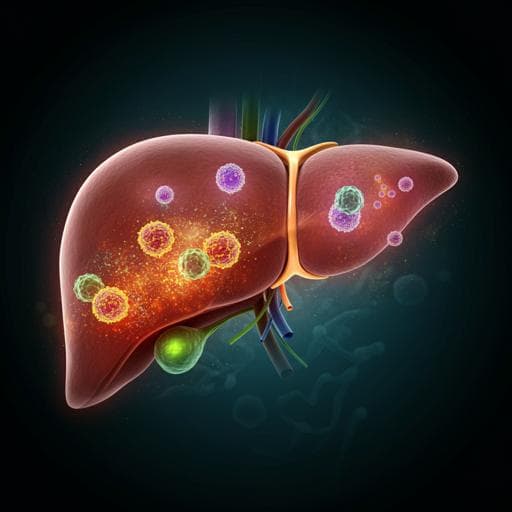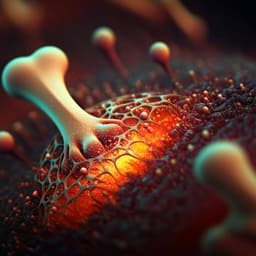
Medicine and Health
Triple hormone receptor agonist retatrutide for metabolic dysfunction-associated steatotic liver disease: a randomized phase 2a trial
A. J. Sanyal, L. M. Kaplan, et al.
Retatrutide, a novel triple agonist, has shown remarkable efficacy in significantly reducing liver fat among participants suffering from metabolic dysfunction-associated steatotic liver disease. This 24-week study led by Arun J. Sanyal and colleagues highlights the potential transformative effects of this treatment, with reductions in liver fat reaching as high as 82.4%.
~3 min • Beginner • English
Introduction
Metabolic dysfunction-associated steatotic liver disease (MASLD) is highly prevalent and closely linked to obesity and insulin resistance. Progression to metabolic dysfunction-associated steatohepatitis (MASH) can lead to fibrosis, cirrhosis, and transplantation. No therapies are currently approved in the US or Europe. Incretin-based agents (GLP-1 receptor agonists and GIP/GLP-1 dual agonists) reduce weight and liver fat but may not maximally defat the liver. Retatrutide is a triple GIP/GLP-1/glucagon receptor agonist with weekly dosing and robust weight loss in obesity. This study tests whether retatrutide reduces liver fat in people with MASLD and explores relationships with weight, abdominal adiposity, and metabolic biomarkers, addressing a critical need for effective MASLD therapies.
Literature Review
Prior studies show GLP-1 mono-agonists (e.g., semaglutide) and GIP/GLP-1 dual agonists (tirzepatide) reduce liver fat and improve MASH biomarkers, with semaglutide demonstrating histologic improvement in noncirrhotic MASH. Triple agonists (GLP-1/GIP/GCG), such as efocipegtrutide, have shown significant hepatic fat reduction in early trials. Adding glucagon receptor agonism may enhance hepatic fat oxidation beyond weight loss effects alone; dual GLP-1/GCG agonists (e.g., efinopegdutide) have shown greater liver fat reduction than GLP-1 at similar weight loss. Conversely, glucagon receptor antagonism increases liver fat in T2D. Thus, multi-receptor agonism may yield superior hepatic defatting compared with single or dual incretin agonists.
Methodology
Design: Randomized, double-blind, placebo-controlled, multicenter phase 2a substudy (United States) of a 48-week phase 2 obesity trial (NCT04881760). Participants: Adults with obesity (BMI ≥30 kg/m²) or overweight (BMI ≥27 to <30 kg/m²) with weight-related complications (excluding T2D) who also had MASLD with MRI-PDFF liver fat ≥10%. Key exclusions included MRI contraindications and claustrophobia. Enrollment used an XGBoost-based ML enrichment to identify candidates likely to have liver fat ≥10% for MRI screening.
Randomization and masking: In the main study, participants were randomized using an interactive web response system in a 2:1:1:1:1:2:2 ratio across retatrutide dose/start-dose arms and placebo, stratified by sex, BMI (<36 or ≥36 kg/m²) and substudy participation; in this substudy, 98 participants were randomized to once-weekly subcutaneous retatrutide 1 mg (n=20), 4 mg (n=19; pooled start doses), 8 mg (n=22; pooled start doses), 12 mg (n=18) or placebo (n=19) for 48 weeks. Investigators, participants, and sponsor were blinded; study drugs were provided in matching vials with dose escalation every 4 weeks per protocol.
Assessments: MRI-PDFF to quantify hepatic fat fraction and MRI-based body composition for visceral adipose tissue (VAT) and abdominal subcutaneous adipose tissue (ASAT) at baseline, week 24, and week 48 (±14 days). Consistent scanner/protocol per participant; central review by qualified vendors. Serum biomarkers at baseline, week 24 and week 48 included ALT, AST, FIB-4, ELF, K-18, pro-C3, and metabolic markers (fasting insulin, C-peptide, HOMA2-IR, triglycerides, adiponectin, leptin, β-hydroxybutyrate, free fatty acids, FGF21). Standardized diet and physical activity counseling provided to all participants.
Outcomes: Primary—relative change in liver fat (MRI-PDFF) at week 24 versus placebo for each retatrutide dose. Key secondary—relative liver fat change at week 48; absolute liver fat change at weeks 24 and 48; proportion achieving ≥30% relative liver fat reduction. Exploratory—proportions achieving ≥50% and ≥70% relative reduction and liver fat <5%; changes in VAT, ASAT, metabolic and MASH/fibrosis biomarkers; correlations between liver fat change and body weight, abdominal depots, and biomarkers.
Statistics: Efficacy analyses used the efficacy estimand on all randomized substudy participants; data after intercurrent events (e.g., treatment discontinuation) were excluded. Continuous endpoints: mixed model for repeated measures with fixed effects for treatment, visit, stratification factors and their interactions, baseline as covariate, participant as random effect; no imputation for missing continuous data. Binary endpoints: logistic regression (treatment, stratification factors as fixed effects; baseline as covariate); multiple imputation under missing at random for creating binary responses from imputed continuous liver fat values; Rubin’s Rule for inference. Correlations via Spearman or power models. Two-sided α=0.05; 95% CIs reported; no multiplicity adjustments. Sample size targeted ~100 to ensure ≥80% power to detect a 30% treatment effect (SD 27.28%) at week 24 allowing 20% dropout. Analyses conducted in R 4.2.2.
Key Findings
Participants: Of 338 randomized in the main study, 98 (29.1%) had MRI-PDFF liver fat ≥10% and entered the MASLD substudy: placebo (n=19), retatrutide 1 mg (n=20), 4 mg (n=19), 8 mg (n=22), 12 mg (n=18). Baseline mean age 46.6 years; weight 110.2 kg; BMI 38.4 kg/m²; 46.9% female; 98% White; 41.8% Hispanic/Latino.
Primary endpoint (week 24 relative liver fat change, LSM vs baseline):
- Placebo: +0.3%
- Retatrutide 1 mg: −42.9% (ETD vs placebo −43.2%, 95% CI −58.9 to −27.4; P<0.001)
- Retatrutide 4 mg: −57.0% (ETD −57.3%, −75.7 to −38.9; P<0.001)
- Retatrutide 8 mg: −81.4% (ETD −81.7%, −94.2 to −69.2; P<0.001)
- Retatrutide 12 mg: −82.4% (ETD −82.7%, −95.2 to −70.2; P<0.001)
Week 48 relative liver fat change (LSM): placebo −4.6%; retatrutide 1 mg −51.3% (ETD −46.7%; P<0.001), 4 mg −59.0% (ETD −54.4%; P<0.001), 8 mg −81.7% (ETD −77.1%; P<0.001), 12 mg −86.0% (ETD −81.4%; P<0.001).
Categorical liver fat outcomes:
- Week 24: ≥30% reduction achieved by 71–100% across retatrutide doses vs 4% placebo; ≥50% by 43–100%; ≥70% by 22–86% on retatrutide. Liver fat <5% achieved by 79% (8 mg) and 86% (12 mg) vs 0% placebo.
- Week 48: ≥30% reduction 63–100% across doses vs 21% placebo; ≥50% 43–100%; ≥70% 32–93%. Liver fat <5%: 89% (8 mg), 93% (12 mg).
Body weight and waist: Significant, dose-related weight loss vs placebo at weeks 24 and 48 (all P<0.001). Percent change at week 48: placebo −0.1%; 1 mg −8.6%; 4 mg −16.3%; 8 mg −23.8%; 12 mg −25.9%. Waist circumference reduced up to −19.2% at week 48.
Abdominal depots: VAT reduced by −13.8% to −31.5% at week 24 and −16.1% to −48.3% at week 48 across retatrutide doses vs increases on placebo; ASAT reduced −12.9% to −26.3% (week 24) and −13.2% to −43.5% (week 48). Dose dependence more evident by week 48.
Correlations: Liver fat reduction strongly correlated with percent change in body weight (week 24 r=0.800; week 48 r=0.739; both P<0.001), waist circumference (r=0.652 and 0.601), VAT (r=0.792 and 0.745), and ASAT (r=0.742 and 0.703). Near-maximal liver fat reductions occurred with ~20% weight/waist and ~40% VAT/ASAT reductions.
Metabolic biomarkers (vs placebo): At week 48, fasting insulin reduced up to −70.9% (≥4 mg; P≤0.01), C-peptide up to −50.5% (≥8 mg; P<0.001), HOMA2-IR (insulin) up to −69.3% (≥4 mg; P<0.001), HOMA2-IR (C-peptide) up to −54.5% (≥8 mg; P<0.001). Triglycerides reduced up to −49.4% (≥4 mg; P<0.001). Adiponectin increased (≥4 mg; P<0.05). Leptin decreased (≥4 mg at 24 weeks; ≥8 mg at 48 weeks). β-hydroxybutyrate increased dose-dependently at ≥4 mg (notably at 12 mg; week 48 P=0.003). FGF21 decreased at ≥4 mg (varied by timepoint). Liver fat changes correlated significantly with changes in insulin, C-peptide, HOMA2-IR, triglycerides, adiponectin, leptin, and FGF21 (P<0.05).
MASH/fibrosis biomarkers: K-18 decreased significantly with 8 mg (week 24) and 8–12 mg (week 48) up to −49.6%. Pro-C3 decreased significantly with ≥4 mg at week 24 and with 1, 4, 8 mg at week 48 (up to −26.4%). Mean ALT, AST, FIB-4, and ELF did not consistently change vs placebo.
Safety: Adverse events were predominantly transient, mild-to-moderate gastrointestinal events, more frequent at 8 mg and 12 mg. Serious AEs occurred in 2 participants (2.0%): acute cholecystitis with vomiting (one participant) and clear cell renal cell carcinoma (one participant). No hepatotoxicity signals were observed in eDISH analyses; no ketoacidosis despite β-hydroxybutyrate increases.
Discussion
Retatrutide produced profound and rapid reductions in hepatic fat in people with MASLD, with 80% or more achieving ≥70% liver fat reduction and over 85% achieving liver fat content <5% at the highest doses within 24 weeks. Liver fat reductions closely tracked weight loss and reductions in VAT/ASAT, with a near-maximal defatting around 20% weight loss, suggesting a physiological floor to hepatic fat content. Compared with GLP-1 mono-agonists and GIP/GLP-1 dual agonists, retatrutide’s triple agonism may confer additional hepatic fat reduction via glucagon receptor–mediated increases in fatty acid oxidation, supported by dose-related rises in β-hydroxybutyrate. Improvements in insulin resistance markers and triglycerides, alongside reductions in K-18 and pro-C3, reinforce potential benefits on metabolic health and fibrogenic activity. Together, the findings address the key question of whether triple receptor agonism can substantially defat the liver in MASLD and indicate retatrutide’s strong therapeutic promise.
Conclusion
In this randomized, double-blind, placebo-controlled phase 2a substudy, once-weekly retatrutide achieved large, dose-dependent liver fat reductions, substantial weight loss, and improvements in abdominal fat depots and metabolic biomarkers in adults with MASLD. Hepatic steatosis resolved in the majority at 8 mg and 12 mg. These results support retatrutide as a promising candidate therapy for MASLD. Future studies should assess histologic outcomes, effects on fibrotic MASH, advanced fibrosis/cirrhosis populations, durability after treatment cessation, and impacts on long-term liver-related clinical outcomes.
Limitations
Limitations include the relatively small substudy sample (n=98), geographic and racial homogeneity (US-only, predominantly White), exclusion of patients with type 2 diabetes, absence of liver histology, lack of enrichment for MASH or significant fibrosis, no multiplicity adjustment despite numerous statistical tests, and missing week 48 MRI data for 56.1% of participants, limiting interpretation of dose-response at week 48. The results should be considered hypothesis-generating rather than definitive.
Related Publications
Explore these studies to deepen your understanding of the subject.







